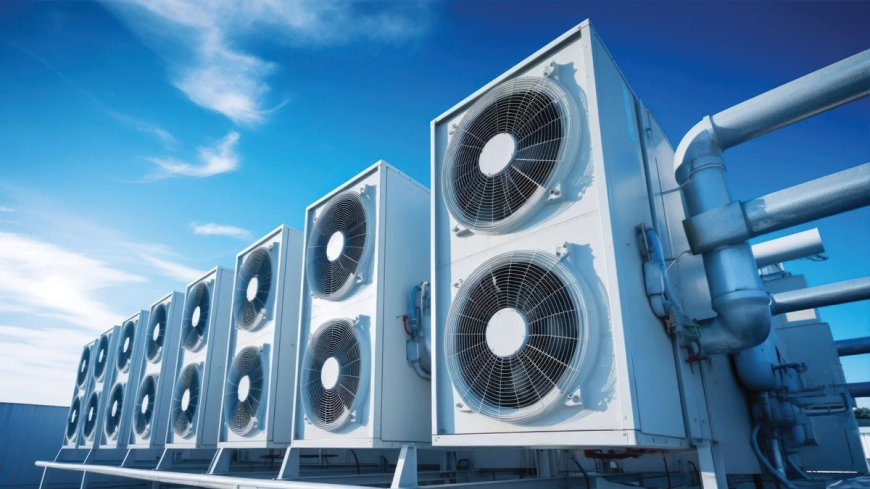Role of sustainable HVAC solutions in green building ecosystem
As the world faces the challenges of climate change and extreme weather patterns, the importance of sustainability in building design and operation is more critical than ever.

As the world faces the challenges of climate change and extreme weather patterns, the importance of sustainability in building design and operation is more critical than ever. With the global population rising and urbanization accelerating, there is a natural shift seen towards energy-efficient and environmentally responsible, healthy buildings. Sustainable buildings aim to reduce their environmental impact by prioritizing the well-being of occupants while optimizing resource use.
A key component of this shift toward sustainable architecture is the use of energy efficient and sustainable HVAC (Heating, Ventilation, and Air Conditioning) systems. HVAC systems have become essential for maintaining indoor comfort by regulating temperature, humidity, air quality, and overall environmental conditions. As buildings attempt to reduce their environmental footprint and enhance energy efficiency, incorporating efficient HVAC solutions becomes crucial. These systems are designed to minimize energy consumption, reduce carbon emissions, and improve the occupant’s thermal comfort.
The need for sustainable HVAC solutions
The building sector is one of the largest consumers of energy globally, contributing significantly to carbon emissions. According to the United Nations Environment Programme (UNEP), buildings account for approximately 40% of global energy consumption and 30% of energy-related greenhouse gas emissions. In rapidly urbanizing regions like India, the demand for energy-intensive technologies such as HVAC systems is rising. Conventional HVAC systems often result in high energy consumption, poor air quality, and environmental degradation.
In response to these challenges, sustainable HVAC solutions offer a promising approach to mitigate the negative environmental impacts of buildings. A major benefit of sustainable HVAC systems is their ability to improve energy efficiency. Conventional HVAC systems typically consume substantial amounts of energy, driving up operational costs and increasing greenhouse gas emissions. In contrast, sustainable alternatives—such as smart thermostats and variable-speed fans—adjust heating and cooling based on real-time demand, ensuring energy is used only when necessary. These adaptable systems provide optimal comfort without overwhelming the building's energy supply, playing a vital role in reducing environmental impact.
Key principles of sustainable HVAC systems
Sustainable HVAC systems aim to minimize environmental impact, reduce energy consumption, and enhance occupant comfort through several key principles. These systems incorporate advanced technologies, such as Geothermal Cooling Systems, Evaporative Cooling Systems, Variable Refrigerant Flow (VRF), Energy Recovery Ventilators (ERVs), and high-efficiency heat pumps. These innovations ensure energy is used only when necessary, adjusting operations in real time to achieve significant energy savings.
Many sustainable HVAC solutions integrate renewable energy sources like solar or geothermal power. This reduces reliance on non-renewable resources, helping to lower carbon emissions while improving overall energy efficiency in buildings. This integration supports long-term sustainability goals by creating an eco-friendlier and energy-efficient environment.
Maintaining high indoor air quality (IAQ) is a vital aspect of sustainable HVAC systems. These systems use high-efficiency filters and demand-controlled ventilation to keep indoor air clean and healthy, effectively managing pollutants, allergens, and excess moisture. By improving IAQ, these systems contribute to the health and well-being of building occupants.
Water conservation is also a critical component of sustainable HVAC solutions. Technologies like condensate recovery and rainwater harvesting help reduce water waste by repurposing recovered water for non-potable uses. Additionally, smart controls and automation optimize system performance by adjusting heating, cooling, and ventilation based on factors like occupancy and weather, ensuring energy efficiency and occupant comfort while reducing unnecessary energy consumption.
Benefits of sustainable HVAC solutions in green buildings
Integrating sustainable HVAC solutions into green buildings provides significant benefits for building owners, occupants, and the environment. These systems optimize energy usage by adjusting to real-time needs, reducing energy consumption, and lowering operational costs. When paired with renewable energy sources like solar or geothermal, they further decrease reliance on grid electricity, providing additional long-term savings.
Sustainable HVAC systems also contribute to a reduced environmental impact. By improving energy efficiency and incorporating renewable energy, they lower a building's carbon footprint and help meet global climate goals, such as those set by the Paris Climate Agreement. These systems enable buildings to achieve net-zero or even lower energy consumption, playing a vital role in mitigating climate change.
In addition to energy savings, sustainable HVAC systems enhance indoor air quality and occupant comfort. By reducing pollutants like Volatile Organic Compounds (VOCs), allergens, and particulate matter, they improve health and reduce the risk of respiratory issues. Effective humidity control ensures a comfortable environment, leading to higher occupant satisfaction, retention, and a more desirable living or working space.
Indian Green Building Council: Building rating systems
The Indian Green Building Council (IGBC) aligns its rating programs with national standards, including the Ministry of Environment, Forest & Climate Change (MoEF&CC) guidelines, the Bureau of Energy Efficiency (BEE) Star Rating Programme, the Energy Conservation Building Code (ECBC), and the National Building Code (NBC). These alignments ensure that certified buildings meet stringent environmental and energy efficiency benchmarks. A key component of IGBC’s approach is optimizing energy consumption through efficient building envelope design, advanced lighting systems, and high-performance HVAC solutions. By incorporating passive cooling techniques, natural ventilation, and energy-efficient building materials, IGBC-certified structures significantly reduce reliance on artificial heating and cooling.
HVAC systems play a critical role in a building’s overall energy performance, and IGBC emphasizes the adoption of sustainable technologies such as high-efficiency chillers, VRF systems, demand-controlled ventilation, and thermal energy storage. Additionally, integrating smart metering, automated climate controls, and well-insulated building envelopes helps optimize energy use. These measures enable IGBC-certified buildings to achieve energy savings of 20-30%, reducing operational costs while enhancing indoor air quality and occupant comfort. By promoting green HVAC solutions alongside broader sustainability strategies, IGBC supports India’s transition toward more energy-efficient and environmentally responsible built environments.
Conclusion
Sustainable HVAC systems are essential to the success of green buildings. These systems do more than reduce energy consumption; they also create healthier, more comfortable living and working spaces. By focusing on energy efficiency, utilizing renewable energy sources, improving indoor air quality, and incorporating smart automation, sustainable HVAC solutions help create buildings that are environmentally responsible while promoting occupant health and comfort.
Adopting these technologies is a critical step toward building a more sustainable, resilient, and energy-efficient environment. As the green building movement grows, the role of sustainable HVAC systems will become increasingly important in shaping the future of construction. By incorporating these advanced systems, we can ensure that buildings are not only better for the environment but also better for the people who inhabit them.








